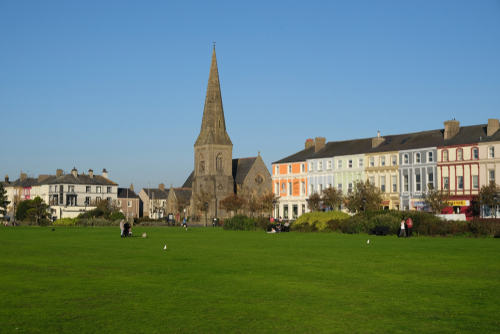
Go to the Cumbria Business Directory
Silloth is a super scenic Cumbria seaside town, nestling on the shores of the Solway Firth with a huge green expanse in the town centre. This is called, not surprisingly “The Green”. So if a quiet pretty seaside resort, with stunning scenery and the Lake District on its doorstep, sounds like fun then read on.

“The Green” at Silloth. Photo: Rodney Hutchinson/Shutterstock.com
Where is Silloth?
Silloth is a small port town, seaside resort and civil parish in Cumbria, northwest England. It’s situated on the shoreline of the Solway Firth, facing the hills of Southern Galloway and backed by the fells of the Lake District. The town’s located some 18 miles (29 km) north of Workington and 22 miles (35 km) west of Carlisle. The town also lies 12 miles (19 km) north of Maryport, along the B5300 coast road.
Silloth is Cumbria’s No 1 seaside resort, well only seaside resort, and is renowned for its superb spacious seafront ‘green’, well-appointed promenade. The town had a permanent resident population of 2,906 at the 2011 Census. but this can rise many-fold in peak season. Ok, now you know where it is how about a little history tour.
Join the Silloth Business DirectoryA Fleeting History
The Romans were the first known settlers in the Solway region, arriving around AD79. Twelve miles south of Silloth, Maryport (Alauna) was a key port for importing supplies needed by Roman forces serving at Hadrian’s Wall, and as a base for defending against attacks from Scotland and Ireland. Consequently, a series of ‘mile forts’ were built along the Solway coast from Maryport to Hadrian’s Wall at Bowness on Solway. After the 4th century Roman withdrawal, the Solway region formed part of the Kingdom of Rheged, until Anglian settlers arrived from Northumbria in the 7th century.
In 1299, the port of Skinburness, just north of Silloth, was the place where King Edward I gathered his 50-strong fleet for the pending battle with the Scots. He defeated the Scottish forces, led by William Wallace, successfully retaking the land around the Solway for England. Soon after, Edward granted Silloth town charters for both a market and a fair. In 1301, the port of Skinburness and much of the surrounding village were destroyed by a great storm, most of which was never rebuilt.
The most turbulent time for the Solway area was the 16th century when the marauding Border Reivers were at the height of their activity. However, the Act of Union, signed in 1707 gradually brought peace to the region. Following the period of relative stability, Skinburness, given its proximity to both Scotland and the tax haven of the Isle of Man, became a well-known haunt for smugglers, who shifted their contraband through the port.
Nineteenth-Century Silloth
Skinburness was also the location chosen by Sir Walter Scott in his novel Red Gauntlet (published 1824) for a fabled meeting between Bonnie Prince Charlie and the Jacobites. Scott wrote the book on location, staying at a locally renowned coach house, the Longhouse. The building is now converted to apartments with the old barn converted to a residential property.
During the early 19th century, celebrated landscape artist JMW Turner came to Silloth on a number of occasions to paint seascape and sunset views of the Solway.
In 1855, construction began on Silloth docks, ultimately to replace Port Carlisle, as the deep-water port for Carlisle. Spoil from the dock was used as fill in the construction of the ‘The Green’, a grassed open space, covering some 36 acres, which still dominates the town’s landscape.
In 1856, with the planned opening of the docks, the construction of the Carlisle to Silloth railway followed. The town then began to develop around the terminus of the railway. And for the first time, Carlisle’s working classes were presented with affordable access to the seaside, via the railway. The town began to flourish as a destination for day-trippers, reaching the peak of its popularity in the late 19th and early 20th centuries.
In June 1939, just before the outbreak of the Second World War, an airfield was built on the outskirts of the town. Originally designed to be used by the RAF Maintenance Command, 22MU, the airfield was handed over to Coastal Command in November 1939. The airfield became the designated home of the Operational Training Unit (OTU), which were responsible for training pilots and crews from the UK and its allies, during the war effort.
The Modern Era
Silloth airport was briefly used by civil aircraft during the 1950s but closed on 31 December 1960. Today, the old aerodrome has been utilised as an industrial park. In 1964, the town’s rail link with Carlisle was closed as part of the swathing cuts recommended by the Beeching Report, in its review of the UK rail network.
Today, tourism is still a major contributor to the economy of Silloth. In particular, there are many static and touring caravan parks located within a few miles radius of the town. This results in a large increase in the town’s population during the summer months.
With its wide, tree-lined streets and outstanding promenade, stretching north towards Skinburness, Silloth has retained much of its Victorian heritage. The town’s main feature is its large, centrally located, 36-acre green, also built in the Victorian era.
This space is utilised for various events throughout the year, which include the local beer, food and kite festivals, and the annual steam rally. In May 2012, ‘the Green’ and its amenities were totally refurbished with lottery funding.
Although there are often brisk winds blowing in off the Solway, the town is renowned for its exceptionally mild winter climate.
Getting to Silloth
By Road
The easiest way to get to Silloth is to drive. Arriving at Carlisle via the M6, you would take the A595 for about 5 miles, as far as Thursby roundabout. Turning on to the A596, you need to travel for a further 6 miles before turning on to the B5302, just south of Wigton. Silloth is a further 11 or 12 miles from the turning. If you are travelling from West Cumbria, then the B5300 coast road from Maryport is a superb scenic route.
By Rail
If you want to travel to Silloth via rail, then the nearest train station is at Wigton. The town is about 12 miles from Silloth on the B5302 road. To get to Wigton by rail, you first need to take the train to Carlisle. Changing on to the Cumbria Coast Line, where trains run to Whitehaven/Barrow approximately every hour, the journey takes about 20 minutes. You will then have to make the 11-mile journey from Wigton to Silloth by taxi or bus.
By Bus
Stagecoach operates 6 buses between Carlisle and Silloth, Monday to Saturday, with reduced service on Sundays. The buses run around every 2 hours, from early morning to late afternoon. The journey takes about an hour, with frequent stops, which include Thursby, Wigton and Abbeytown, along the way. It’s worth noting that this is the same service you’d catch in Wigton if you opted for the journey by train.
Places to see Around Silloth
Holme Cultram Abbey
Holme Cultram Abbey is a 12th-century structure located on the B5302 at the village of Abbeytown, about 5 miles east of Silloth. It still serves as the local parish church. Originally founded by monks from Melrose Abbey in 1150, the building managed to survive both repeated 16th-century raids by the Border Reivers. It also escaped Henry VIII’s dissolution of the monasteries.
The Abbey has had a lot of restoration work over the centuries but the Norman arch over the west door and a fair amount of the interior are largely untouched. Admission and parking are free.
Things to do!
Golf
If you are into golf, then Silloth is definitely the right place for you. The Blitterlees Golf Course is held in high regard within the golfing fraternity and is renowned for great value for money. The exceptionally mild winters make this an all-year-round course.
Gincase Farm Park
Gincase is a large family-orientated themed farm park, with large indoor and outdoor play areas. It also features an animal barn and outdoor paddocks, filled with friendly farm animals There are also go-karts, quad bikes, etc., available for hire. There’s a tearoom serving homemade food, with an adjoining craft and gift shop.
Soldiers in Silloth
Soldiers in Silloth is a private exhibition, featuring a unique collection of more than 5,000 toy soldiers and related items. Collected from all over the world, the displays depict historical periods from ancient Egypt to the Gulf War. Soldiers, knights in armour, cowboys and Indians, Vikings, Romans, etc. Battlefield dioramas such as Gettysburg and Waterloo are also depicted. There are toy soldiers and related books for sale.
Places to Stay?
There are a great number of both static and touring caravan sites close to Silloth. The cost of this type of accommodation varies greatly depending on the time of year, the length of stay (usually a minimum of 1 week) and the available facilities. However, there’s also plenty of holiday home-style accommodation in the area, as well as some hotels and guesthouses, situated within the town itself. A rough guide to overnight accommodation costs are as follows:
Hotels/Guesthouses/B&B: £70 – £100
Holiday Homes: £50 – £70 (pp per night for max. occupancy)
Why Not Try Our Silloth Quiz?
Quiz Maker – powered by Riddle





